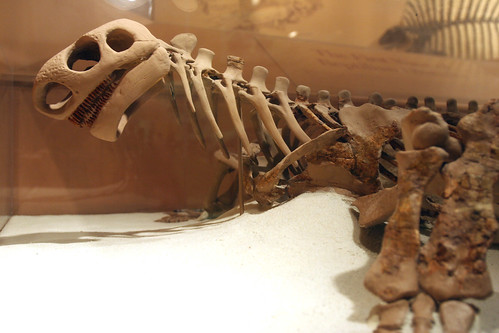[Recent Entries][Archive][Friends][User Info]
| October 30th, 2011 | |
|---|---|
| 11:30 am [industrialterro] [Link] |
Cotylorhynchus Cotylorhynchus was a very large mammal-like reptile (more accurately synapsid) that lived in the southern part of what is now North America during the Early Permian period and persisted until the late-Mid Permian (about 265 mya). Cotylorhynchus are the most well known of the synapsid clade Caseidae and are in the order Pelycosauria. The Cotylorhynchus were the largest pelycosaurs, the largest terrestrial vertebrates of their time, as well as the terrestrial vertebrates up to that time. They were herbivores, and because of their enormous size they probably did not fear any of the carnivores. Cotylorhynchus was a massively built animal with a disproportionately small head and a huge barrel-shaped body. They could grow to lengths of up to 20 feet and could achieve weights of up to 2 tons. Their skeletal features included a massive scapulocoracoid, humeri with large flared ends, stout forearm bones and broad, robust hands that had large claws. Certain features of their hands indicate that they had to dig considerably to obtain their food supply and also they may have used these features to dig burrows for shelter or safety. Their digits were believed to have a considerable range of motion and large retractor processes on the ventral surfaces of the unguals allowed them to flex their claws with powerful motions. Also, the articulatory surfaces of their phalanges were oblique to the bone's long axis rather than perpendicular to it. This allowed for much more surface area for the flexor muscles. Their skulls are distinctive in the presence of large temporal openings and very large nostril openings, which could have been utilized for better breathing or may have housed some sort of sensory or moisture conserving organ. Also they featured large pineal openings and a snout or upper jaw that overhangs the row of teeth to form a projecting rostrum. Rounded deep pits and possibly large depressions were present on the outer surface of the skull. Their teeth were very similar to those of iguanas with posterior marginal teeth that bore a longitudinal row of cusps. Котилоринх (Cotylorhynchus) — верхние горизонты ранней перми (кунгурская эпоха) Техас и Оклахома. Крупнейший представитель казеид. Типовой вид (Cotylorhyncus romeri) мог достигать почти 3 метров в длину. Самый крупный вид — Cotylorhynchus hancocki, до 6 метров в длину и весом до 2 тонн. Никогда ранее растительноядное наземное позвоночное не достигало таких размеров. Вид был описан Олсоном и Бирбауэром в 1953 году из среднепермских слоев свиты Сан-Анжело (кунгурская эпоха, около 270 млн л.н.) в Техасе. Типовой вид котилоринха описан по хорошо сохранившимся полным скелетам. Это неуклюжее животное с очень маленькой головой, уплощенным бочкообразным телом, длинным хвостом и очень мощными короткими ногами. Очень мощные когти на передних и задних лапах, фаланговая формула сокращена. Котилоринх Хэнкока плохо известен, но отличался более мощными конечностями, когти передних лап достигали 7—8 см в длину. Третий вид — Cotylorhyncus bransoni — из средней части формации Флауэрпот в Оклахоме. Он близок по размеру к типовому виду, но отличался рядом деталей строения, в том числе более короткими конечностями.
Репродукции (1, 2, 3, 4, 5, 6, 7):
Размеры в сравнении с человеком:
Ископаемые останки (1, 2, 3, 4):
Tags: Вымершие синапсиды, Пермь, пеликозавры |






/Cotylo_01.jpg)




